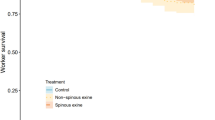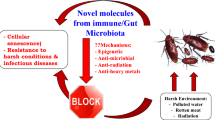Abstract
Beeswax is composed of fatty acids, odd numbered n-alkanes and wax esters. Focusing on the most stable components of beeswax, namely the n-alkanes, we have found by gas chromatography and gas chromatography-mass spectrometry analyses of combs from twelve colonies from Israel and Jordan that as beeswax ages and darkens its n-alkane composition changes. The amount of even numbered n-alkanes (C22– C32) is significantly higher in darker colored beeswax as compared to light colored beeswax. We attribute this in part to the accumulation of cuticular residues found in the darker colored comb cells. Cuticular residues are known to contain C23–C32 odd and even numbered n-alkanes.
Zusammenfassung
Die Hauptbestandteile von Bienenwachs sind fettlösliche Substanzen wie Fettsäuren, langkettige Alkohole, geradzahlige n-Alkane und Wachsester (Tulloch, 1970; Aichholz and Lorbeer, 2000). Wir untersuchten die Zusammensetzung der n-Alkane in unterschiedlich gefärbtem Bienenwachs. Die Farbveränderungen der Wabe sind von der Brutaktivität abhängig und die dunkle Farbe soll durch eine Anhäufung von Resten der Nymphenhäutchen verursacht werden (Jay, 1963, Hepburn and Kurstjens, 1988; Hepburn et al., 1991; Berry and Delaplane, 2001). Gaschromatographie (GC) und GC—Massenspektrometrie wurden für die Analysen eingesetzt (Evershed et al., 1997; Regert et al., 2001). Wie bestätigten, dass helles Bienenwachs vor allem ungeradzahlige Alkane enthält. Überraschenderweise stellten wir fest, dass das dunkle Bienenwachs zusätzlich zu den ungeraden Alkanen durchschnittlich drei Mal mehr geradzahlige Alkane enthält (Abb. 3 und 4). Die Quelle für die geradzahligen Alkane im dunkleren Bienenwachs sind sehr wahrscheinlich die Wachse auf der Bienenkutikula, die sich im Bereich des Brutnestes anreichern. Es ist bekannt, dass diese Kutikulawachse sowohl geradzahlige als auch ungeradzahlige Alkane enthalten (Salvy et al., 2001). Dieser neue Befund zeigt, dass unterschiedliche Aktivitäten der Bienen innerhalb des Bienenvolkes Auswirkungen auf die Zusammensetzung des Bienenwachses haben (Hepburn and Kurstjens, 1988; Berry and Delaplane, 2001).
Similar content being viewed by others
References
Aichholz R., Lorbeer E. (2000) Investigation of combwax of honeybees with high-temperature gas chromatography and high-temperature gas chromatography chemical ionization mass spectrometry. II:High temperature gas chromatography chemical ionization mass spectrometry, J. Chromatogr. A 883, 75–88.
Asperger A., Engewald W., Fabian G. (1999) Analytical characterization of natural waxes employing pyrolysis-Gas Chromatography-Mass Spectrometry, J. Anal. Appl. Pyrolysis 50, 103–115.
Berry J.A., Delaplane K.S. (2001) Effects of comb age on honey bee colony growth and brood survivorship, J. Apic. Res. 40, 3–8.
Blomquist G.J., Jackson L.L. (1973) Incorporation of labelled dietary n-alkanes into cuticular lipids of the grasshopper, malenoplus sanguinipes, J. Insect Physiol. 19, 1639–1647.
DeGrandi-Hoffman G., Roth S.A., Loper G.L., Erickson Jr. E.H. (1989) BEEPOP: A honeybee population dynamics simulation mode, Ecol. Model. 45, 133–150.
Evershed R.P., Vaughan S.J., Dudd S.N., Soles J.S. (1997) Fuel for thought? Beeswax in lamps and conical cups from Late Minoan Crete, Antiquity 71, 980–985.
Haddad N.J., Fuchs S. (2004) Honeybee agrobiodiversity: a project in conservation of Apis mellifera syriaca in Jordan, Uludag Bee J. 3, 116–120.
Hepburn H.R., Kurstjens S.P. (1988) The combs of honey bees as composite materials, Apidologie 19, 25–36.
Hepburn H.R., Bernard R.T.F., Davidson B.C., Muller W.J., Lloyd P., Kurstjens S.P., Vincent S.L. (1991) Synthesis and secretion of beeswax in honeybees, Apidologie 22, 21–36.
Heron C., Nemcek N., Bonfield K.M., Dixon D., Ottaway B.S. (1994) The chemistry of Neolithic beeswax, Naturwissenschaften 81, 266–269.
Jay C.S. (1963) The development of honeybees in their cells, J. Apic. Res. 2, 117–134.
Jimenez J.J., Bernal J.L., Aumente S., Toribio L., Bernal J. (2003) Quality assurance of commercial beeswax. Part II. Gas chromatography electrom impact ionization mass spectrometry of alcohols and acids, J. Chromatogr. A 1007, 101–116.
Jimenez J.J., Bernal J.L., Aumente S., del Nozal M.J., Martin M.T., Bernal J. (2004) Quality assurance of commercial beeswax. Part I. Gas chromatography electrom impact ionization mass spectrometry of hydrocarbons and monoesters, J. Chromatogr. A 1024, 147–154.
Lockey K.H. (1988) Lipids of the insect cuticle: Origin, composition and function, Comp. Biochem. Physiol. 89 B, 595–645.
MacLellan A.R. (1978) Growth and decline of honeybee colonies and interrelationships of adult bees, brood, honey and pollen, J. Appl. Ecol. 15, 155–157.
Mills J.S., White R. (1994) The Organic Chemistry of Museum Objects, Butterworth-Heinemann, London.
Regert M., Colinart S., Degrand L., Decavallas O. (2001) Chemical alteration and use of beeswax through time: Accelerated ageing tests and analysis of archaeological samples from various environmental contexts, Archaeometry 43, 549–569.
Salvy M., Martin C., Bagneres A.G., Provost E., Roux M., Le Conte Y., Clement J.L. (2001) Modifications of the cuticular hydrocarbon profile of Apis Mellifera worker bee in the presence of the ectoparasitic mite Varroa jacobsoni in brood cells, Parasitology 122, 145–159.
Tulloch A.P. (1970) The composition of beeswax and other waxes secreted by insects, Lipids 5, 247–258.
Tulloch A.P. (1971) Beeswax: structure of the esters and their component hydroxy acids and diols, Chem. Phys. Lipids 6, 235–265.
Tulloch A.P. (1980) Beeswax — Composition and Analysis, Bee World 61, 47–62.
Tulloch A.P., Hoffman L.L. (1972) Canadian beeswax: analytical values and composition of hydrocarbons, free acids and long chain esters, J. Am. Oil Chem. Soc. 49, 696–699.
Author information
Authors and Affiliations
Corresponding author
Additional information
Manuscript editor: Jean-Noël Tasei
Rights and permissions
About this article
Cite this article
Namdar, D., Neumann, R., Sladezki, Y. et al. Alkane composition variations between darker and lighter colored comb beeswax. Apidologie 38, 453–461 (2007). https://doi.org/10.1051/apido:2007033
Received:
Revised:
Accepted:
Issue Date:
DOI: https://doi.org/10.1051/apido:2007033




